Italian murders and Ninja intrigue from Radiance
In addition to the four Mafia movies released by Radiance which I recently wrote about, the label has issued a pair of lesser-known Italian mysteries, again in excellent editions.
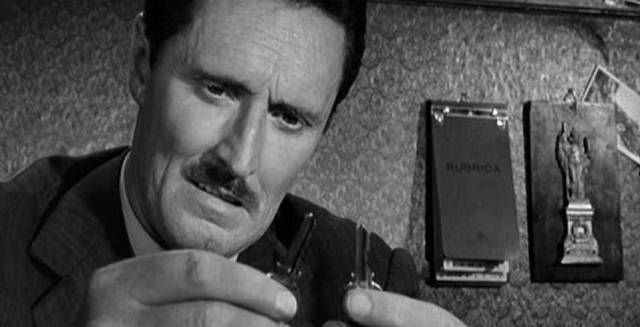
The Facts of Murder (Pietro Germi, 1959)
Pietro Germi, a writer, director and actor, began his career in the immediate post-War period, making movies from the mid-’40s to the late ’50s which blended crime and social issues, drawing on neorealism in style and themes. In the early ’60s, he switched to comedy with the award-winning Divorce Italian Style (1961) and Seduced and Abandoned (1964), a change of direction not quite as radical as it might seem, as these movies continued his close examination of hypocrisy and corruption in Italian society. Those themes are at the heart of the film which immediately preceded the comedies, a police procedural called The Facts of Murder (1959).
The peace of a Roman apartment building is abruptly broken by shouts and gunshots as a man races down the stairs and disappears into the street. Il Commissario Ingravallo (co-writer and director Germi) arrives to investigate and is frustrated when the victim of a robbery is less than cooperative. We eventually learn that the man, art dealer Anzaloni (Ildebrando Santafe) prefers not to make a fuss because the thief was a male prostitute he had picked up in a bar. But by then, Ingravallo has a more serious case to deal with.
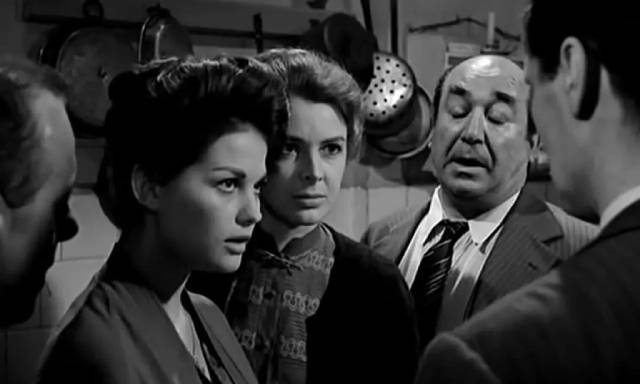
The day after the robbery, Anzaloni’s neighbour Liliana Banducci (Eleonora Rossi Drago) is found beaten to death by her cousin Massimo Valdarema (Franco Fabrizi). Suspicions fall in multiple directions as the inspector digs into the dead woman’s life, with numerous apparent motives – she had recently changed her will to her husband’s disadvantage; there is something odd about her relationship with her cousin; her maid Assuntina (Claudia Cardinale) has a boyfriend, Diomede (Nino Casteluovo), who seems shady. Ingravallo shows no special consideration for those higher on the social scale, leaning on everyone with equal force until he unearths all the secrets which may or may not bear on the case, ultimately leading to a rather sad and pathetic resolution.
The blend of social commentary, mystery and neorealist noir is tightly controlled by Germi, both as director and star, with Leonida Barboni’s cinematography grounding the narrative in images which are both atmospheric and realistically gritty. The Radiance transfer is excellent and the supplements provide enough information about Germi to make you wonder why he remains much less well-known than many of his contemporaries. There’s also a visual essay on the influence of film noir on Italian cinema which contains enticing clips from other little-known movies.
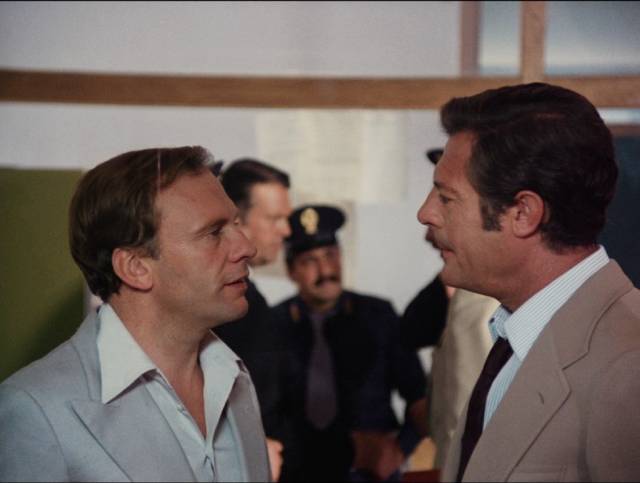
The Sunday Woman (Luigi Comencini, 1975)
More overtly satirical, and largely concerned with bourgeois characters and their jaded attitudes, Luigi Comencini’s The Sunday Woman (1975) is also centred on the police investigation of a murder and what it exposes of hidden vices and hypocrisy. When the obnoxious, crude architect Garrone (Claudio Gora) is bludgeoned to death with a large carved phallus, the lives of those in his social circle are exposed to the probing of Commissioner Salvatore Santamaria (Marcello Mastroianni), who is warned by his superiors to tread lightly because the case involves important and influential people.
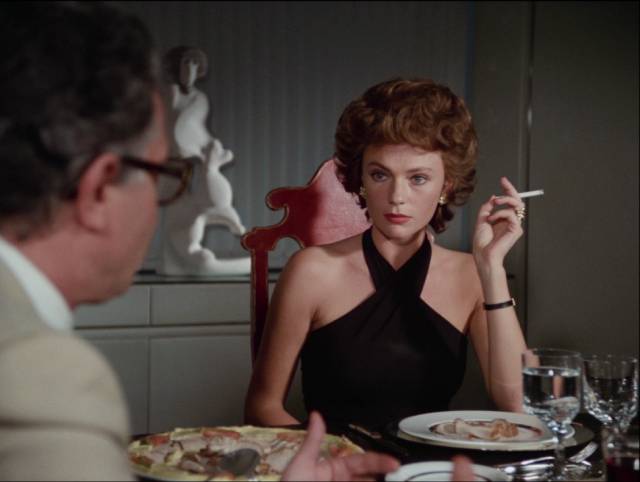
Among the possible suspects are Anna Carla Dosio (Jacqueline Bissett) and Massimo Campi (Jean-Louis Trintignant), who initially seem to be having an affair but turn out to be friends fond of playing games at the expense of their wealthy friends. They come to Santamaria’s attention when a dismissed servant brings him a discarded draft of a letter from Anna to Massimo which asserts that it’s time to get rid of Garrone. Under polite questioning, Anna provokes the Commissioner with her open contempt for their social circle and lack of concern about an alibi. Massimo seems more circumspect and we learn that he has reason for wanting to keep a low profile: he’s a gay man whose younger lover, Lello (Aldo Reggiani), is becoming impatient with Massimo’s caution, rooted in fear of exposure.
Lello, a clerk in the city planning office, starts his own investigation which eventually uncovers some shady dealings by Garrone in connection with the estate of the Tabusso sisters, Virginia (Maria Teresa Albani) and Ines (Lina Volonghi), who harbour their own secret while demanding that the police do something about all the sex workers who make use of their wooded property. It is actually Lello who figures out the truth about Garrone’s murder, but before he can pass on what he’s learned, he too is bludgeoned to death, though this second murder does eventually lead Santamaria to a solution.

While the mystery is handled deftly by Comencini, his real interest is in the flaws of the privileged characters. The film is as much a comedy of manners as a murder story and the excellent cast handle their roles with a deft comic touch.
The Radiance disk presents the film in two aspect ratios, for some reason – open matte 1.33:1 and 1.85:1, the latter cropping a lot of empty top and bottom space from the frame. Typical of Italian films, the foreign stars are dubbed in Italian, but Bissett and Trintignant’s performances don’t suffer. There are new interviews with academics Richard Dyer and Giacomo Scarpelli, plus archival interviews with Trintignant and cinematographer Luciano Tovoli, for whom this was one of seven movies he shot in 1975 (including Michelangelo Antonioni’s The Passenger).
*
The label also recently released four Japanese movies made during the same period as the two Italian titles – a three-disk box set of Ninja films from the early ’60s and a pulp thriller from 1966.
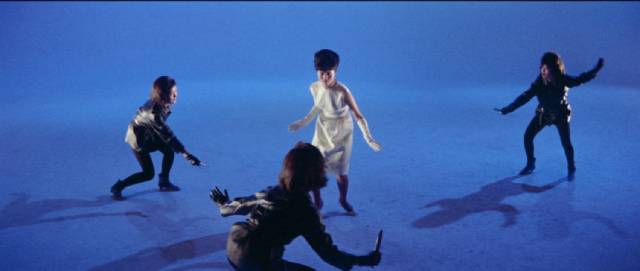
Black Tight Killers (Yasuharu Hasebe, 1966)
In an interview on Radiance’s Blu-ray of Black Tight Killers (1966), it’s not surprising to hear director Yasuharu Hasebe say that he had worked as an assistant to Seijun Suzuki at Nikkatsu (though apparently there’s little documentation of Hasebe’s work before he became a director himself). His debut film has many echoes of Suzuki’s style – kinetic energy driven by a jazzy score, a bright artificial colour palette which discards any pretense to realism, an embrace of comic book violence … in fact, Black Tight Killers is one of the best Seijun Suzuki movies not made by Suzuki himself, up there with Tokyo Drifter (1966) and Branded to Kill (1967).
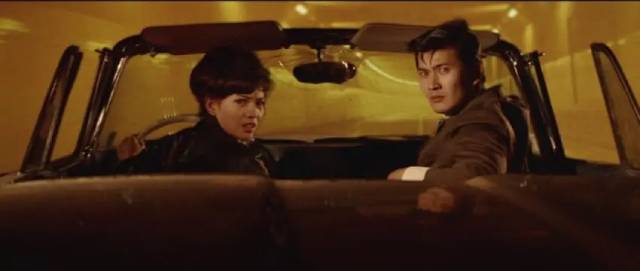
In the opening sequence, photojournalist Daisuke Hondo (Akira Kobayashi) is caught up in a nighttime battle in Vietnam, establishing a certain casual disregard for personal danger. On his flight back to Japan, he’s attracted to flight attendant Yoriko Sawanouchi (Chieko Matsubara) and talks her into a dinner date. In the restaurant, she’s unsettled by a man she thinks is following her; when Hondo goes to investigate, she disappears and he goes looking for her. Finding the mysterious man in a nearby alley, Hondo is caught up in a fight during which three women dressed in black attack and kill the man, grabbing Yoriko and making a getaway in a car, leaving him to take the rap for the murder.
Vouched for by an American friend, he’s released by the police and sets out to find Yoriko. As he investigates, he keeps finding himself caught between a gang of violent men and the women in black – who apparently work under cover as go-go dancers in a nightclub. The more he learns, the more it seems that the killer women are not actually the bad guys, even if they do treat Hondo as an annoyance to be pushed out of the way. It all comes down to a stash of gold stolen by Yoriko’s father at the end of the war. The women are from an island community who rightfully own the gold; the men are Japanese and American acquaintances of Yoriko’s father, who believe she must know where the loot is hidden.
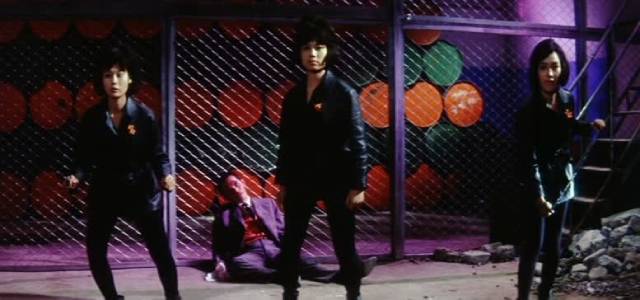
The bodies pile up as the various factions close in on the hiding place, with fights, knifings and shootings climaxing in a helicopter attack at the ruins of a military base on an island. Along the way, Hasebe stages the action with tongue-in-cheek vigour, while frequent Suzuki collaborator Kazue Nagatsuka’s cinematography uses process shots with brightly-painted backdrops to create a feverish comic book atmosphere. Although it was Hasebe’s debut feature, Black Tight Killers is an audaciously assured slice of pulp entertainment; although he went on to direct three of the Stray Cat Rock movies and one Female Prisoner Scorpion feature, this may be his best film.
Radiance’s vibrant, eye-popping transfer highlights the film’s exaggerated colour scheme which softens the violence and the more perverse aspects of the story prefiguring Nikkatsu’s pinky violence excesses of the ’70s. The disk includes a brief archival interview with Hasebe and a commentary from Jasper Sharp.
*

Shinobi (1962-63)
My general impression of Ninjas has always been of mysterious assassins who possess virtually magical powers – they can fly and travel through the ground, bursting up in fountains of dirt to surprise their victims. On a less mystical level, they are formidable, almost unstoppable fighters dressed head-to-toe in black as they pursue their targets in complete silence, wielding an array of unconventional weapons – the infamous throwing stars, poison darts. They have cropped up numerous times in pulp action movies, from Sam Peckinpah’s The Killer Elite (1975) to Quentin Tarantino’s Kill Bill (2003), not to mention a bunch of Cannon movies in the ’80s, climaxing with Ninja III: The Domination (1984). This was the image I had in mind when I picked up Radiance’s Shinobi box set recently. I didn’t really know anything about the three movies in the set and didn’t look them up before I started watching. There was an immediate sense of disorientation when, instead of pulpy contemporary action, I found myself back in Medieval Japan, gloriously shot in widescreen black-and-white.
This series (the set includes the first three of eight movies) belongs to the dark, violent revisionist genre which re-examined Japanese history in the post-War period, viewing class and politics through a critical lens which traced the nation’s 20th Century militarism back to the warring factions which clashed with one another and oppressed the population through their rigid codes of honour and obsession with loyalty whose purest expression was going willingly to a violent death – movies ranging from Masaki Kobayashi’s Harakiri (1962) and Tadashi Imai’s Revenge (1964) to Yoji Yamada’s The Twilight Samurai (2002).
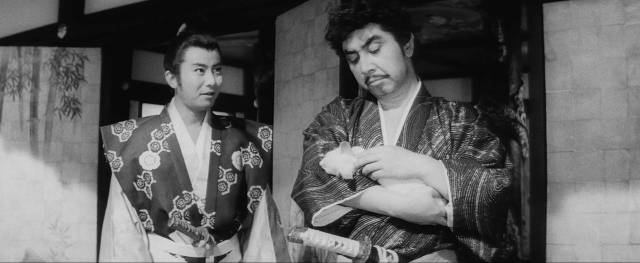
The story is set during the period of feudal wars which were finally resolved with the formation of the Tokugawa Shogunate in the early 17th Century. Among the warring factions are several Ninja clans who sell their deadly skills to others until they themselves are targeted by the powerful warlord Oda Nobunaga (Tomisaburô Wakayama), who is rapidly consolidating his power with an aim to unify the country under his own dictatorship. The first two films – Band of Assassins (1962) and Revenge (1963), both directed by Satsuo Yamamoto – centre on Goemon Ishikawa (Raizô Ichikawa), an ambitious young Ninja who is manipulated by the clan leader into becoming a pariah who, in exile as an outlaw, attempts to assassinate Nobunaga.
The first film ends with Nobunaga’s forces wiping out the clan, with Goemon the only survivor. In the second film, he wants nothing more than to be left alone to live quietly with his wife and child, but when the family is attacked by Nobunaga’s men, he is driven by a personal desire for revenge. The narrative draws to what seems to be a very definite conclusion – with Nobunaga dead, Goemon walks towards a horrific execution (to be boiled alive in oil) – but, despite this grim ending, commercial success compelled Daiei to continue the series. When Yamamoto declined the job, Kazuo Mori stepped in for number three, Resurrection (1963), which picks up with the execution scene, using some Ninja sleight-of-hand to save Goemon.
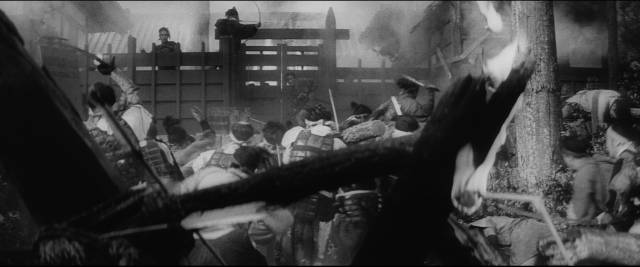
In this episode, several more factions move in to fill the void left by Nobunaga. Events are increasingly being manipulated by Ieyasu Tokugawa, who plays the various warlords against one another in order to consolidate his own power. Goemon is manipulated to serve Tokugawa’s interests by helping to eliminate his rivals. The three films together provide a view of the complicated intrigues of the ruling class as seen from the perspective of a figure who exists on the lower levels of society. There’s a good mix of intrigue and action across the trilogy, with a typically fine cast led by Ichikawa as Goemon and, in the first two films, Wakayama as the boorish Nobunaga, who’s given to petting a cat as he orders his minions to do nasty things. Wakayama, brother of Shintaro Katsu, is best known for playing Ogami Itto in the Lone Wolf and Cub series, but obviously relishes playing the villain here.
Based on a serial novel by leftist writer Tomoyoshi Murayama and in the case of the first two movies directed by the leftist Yamamoto, the Shinobi trilogy paints an unflattering picture of Japanese history, fraught with hypocrisy dressed as honour and nobility, full of cruelty and violence. Despite each film being shot by a different cinematographer, there’s a visual consistency typical of Daiei’s period films – the Zatoichi series, the Daimajin trilogy – and all three are given excellent transfers in the two-disk set. Three extras, totalling forty-five minutes, cover the careers of Yamamoto and Ichikawa as well as the history of Ninjas and their place in Japanese popular culture.
*
Addendum
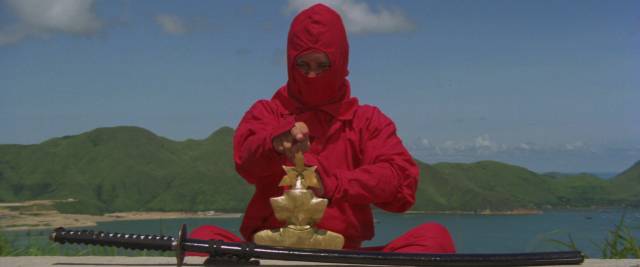
Ninja Terminator (Godfrey Ho/Kim Si-hyun, 1984)
The pop culture version of Ninjas is on display in Godfrey Ho’s Ninja Terminator (1984), in which colour-coded characters use their mystical teleportation skills to pop in and out of view to confuse their opponents. This is a ragged, incoherent movie in which the Ninjas are played by middle-aged white guys (chiefly Richard Harrison, whose career began in Hollywood in the ’50s, moved to Italy in the ’60s and ’70s, finally landing in Asia in the ’80s where he became Godfrey Ho’s go-to white Ninja). Several factions are vying for possession of a three-piece golden Ninja figurine which, when put together, gives its holder ultimate Ninja powers. There are fights and murders on the way to a climactic fight among ruins in the hills above Hong Kong with the rivals doing their teleportation thing.

What makes the movie marginally interesting, though, is the backstory of the production. It actually began life as a Korean martial arts movie called The Uninvited Guest of the Star Ferry, directed by Kim Si-hyun which was bought by the Hong Kong company IFD Films and Arts, whose business model was to buy rights to Korean, Thai and other Asian movies, shoot new scenes mostly involving Ninjas and a few white actors, and then distribute them internationally. This was largely how Godfrey Ho managed to rack up 159 directing credits in twenty-seven years, the majority of which have “Ninja” somewhere in the title. (My only previous encounter with his work was the Cynthia Rothrock movie Undefeatable [1993].)
In the original movie, a man named Tiger (Hwang Jeong-lee) arrives in Hong Kong and offers to help the owner of a restaurant fight a gang who are taking over businesses in Koreatown, and who recently murdered her brother. The plot is thin, but it gives Tiger plenty of opportunities to display his considerable fighting skills (Hwang is particularly impressive with his flying kicks), eventually engaging the gang leader, Jaguar Wong (Jack Lam in an inexplicable flowing blonde wig), in a climactic fight on the beach.
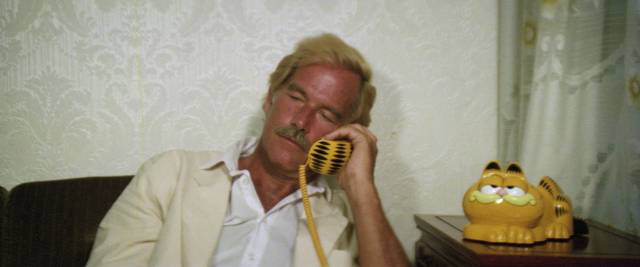
The hybrid Ho version keeps the original fight scenes, repurposes other scenes by dubbing in completely different dialogue – the protection racket becomes a search for the Golden Ninja – and does what it can to tie the new Ninja material to the preexisting footage by way of phone conversations between Tiger and Harrison’s Ninja master Harry, who uses a Garfield phone, which is just one of the movie’s odd details. Another is a toy robot which comes knocking a couple of times to deliver warnings from the bad guys on video tape.
Apart from Hwang’s fighting skills and those amusing odd details, both versions are a bit dull, but Neon Eagle’s two-disk set is relatively lavish. Ninja Terminator gets a vibrant, colourful transfer from the original negative with two commentaries, an interview with Ho and another with Ho and the film’s dubbing director, as well as a piece by Chris Poggiali about Ninja movies (this kind of exploitation/action, not the Japanese period kind). The second disk is a scan of the only known 16mm print of the original Korean movie. Naturally, this is in rough shape – dust, scratches, frame damage – but it’s quite watchable, and to some degree more coherent than Ninja Terminator. Jack Lam still has the blonde wig, but sadly there’s no toy robot or Garfield phone.
Comments
Thanks for reviewing the Shinobi series. I picked up the blu-ray box set from The Unobstructed View. At times they have better prices than amazon. Great movies! Your reviews of Japanese films introduce me to quality movies I previously was unaware of!